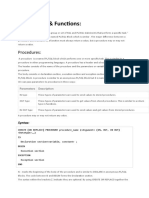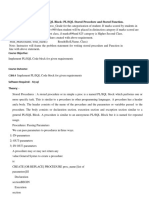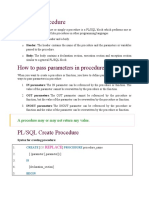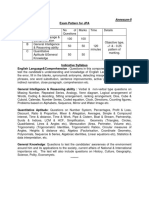0% found this document useful (0 votes)
46 views5 pagesWriteups - Assignment 6
The document discusses PL/SQL stored procedures and functions. It covers the key terminology used in PL/SQL subprograms like parameters, return, and different parameter types. It then explains the characteristics, syntax, and differences between procedures and functions.
Uploaded by
ganesh bagulCopyright
© © All Rights Reserved
We take content rights seriously. If you suspect this is your content, claim it here.
Available Formats
Download as DOCX, PDF, TXT or read online on Scribd
0% found this document useful (0 votes)
46 views5 pagesWriteups - Assignment 6
The document discusses PL/SQL stored procedures and functions. It covers the key terminology used in PL/SQL subprograms like parameters, return, and different parameter types. It then explains the characteristics, syntax, and differences between procedures and functions.
Uploaded by
ganesh bagulCopyright
© © All Rights Reserved
We take content rights seriously. If you suspect this is your content, claim it here.
Available Formats
Download as DOCX, PDF, TXT or read online on Scribd
/ 5



























































